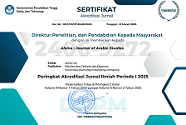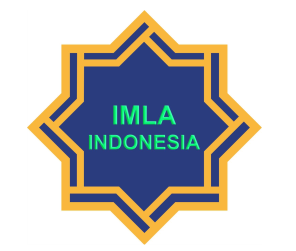Tanfīdh Faṣl al-Munāẓarah fī (Nāfilah) li Tarqiyyati Mahārah al-Kalām
DOI:
https://doi.org/10.21580/alsina.2.1.4211Keywords:
Method, debate, speakingAbstract
This paper searches for the implementation of the debate chapter in (Nafila) to upgrade the speech skills of students of Walisongo State Islamic University Semarang 2019/2018. The background of this research is the lack of good proficiency for students in the Arabic language, especially in the skill of speaking when debating. Nafilah is a member of the Student Activities Union at Walisongo State Islamic University Semarang, who helps her to preserve the Arabic language at the University. The definition of the question in this research is how to implement the debate chapter in (Nafilah) to upgrade the speech skill of students of Walisongo State Islamic University Semarang, especially in the debate class. What are the driving and resistance factors in it? This research is qualitative and descriptive research, and it is carried out at the Walisongo State Islamic University Semarang. The researcher uses interview, observation, and documentation as her data collection methods. As for the data analysis method, it is by triangulating data, sources, and the method. The result of the research is: Nafilah uses the communicative method to achieve a special purpose, which is to upgrade the speech skills of students when debating. Learning to debate in the debate class has two stages. They are the discussion phase and the debate phase. And the implementation of the debate chapter superfluous systems of the Asian Parliament The factors driving and hindering the implementation of this debate chapter are in terms of the conditions of the students, the trainer, and the supervisor.
Downloads
References
أحمد مدكور، على ،2002م، تدريس فنون اللغة العربية (القاهرة: دار الفكر العربى)
خميرة، " تأثير تطبيق طريقة المناظرة على مهارات الكلام لدى الطلاب فصل الخامس مدرسة إبتدائية مصباخ الفلاح دورين مكار ديبوك، بحث علمي، (جاكرتا: قسم تعليم المدرس المدرسة الإبتدائية بكلية علوم التربية و التدريس بجامعة شريف هداية الله،2015)
دكتور حسن شحاتة،1993 م، تعليم اللغة العربية بين النظريات والتطبيق،(القاهرة: الدار المصريةاللبنانية،)
رحمة الهداية، "علاقة بين طريقة المناظرة الفعالة و نمو رغبة الطلاب في تعلم "التشبيه" في المعهد سبيل المتقين لوجريت عانجوك"، بحث علمي، (سورابايا: قسم تعلم اللغة العربية لكلية التربية جامعة سونن أمبيل،2009)
ريتافبرانتا،" فعالية استخدام البيئة المدرسة في ترقية مهارة الكلام، بحث تجري في المدرسة الثانوية الحكومية سوريابووانا-جاوى الشرقية"، بحث علمي، (مالانج: قسم تعليم اللغة العربية كلية الدراسات العليا بجامعة الإسلامية الحكومية مولانا مالك إبراهم، 2009).
سلامي، عبد اللطيف 2014م، المدخل إلى فن المناظرة،(الدوحة: دار بلومزبري مؤسسة قطر).
عبد البارى عصر، حسن، 2005م، مهارات تدريس النحو العربى النظرية و التطبيق، (إسكندرية: مركز الإسكندرية للكتاب).
على الخولي، محمد،2000م، المهارات الدراسية، (الأردان: دار الامل للنشر و التوزيع).
فهمى حجازى، محمود، 2003 م، أسس اللغة العربية، (القاهرة: دار الثقافة للطباعة و النثر ).
كوين، سايمون، 2010م المرشد في المناظرة نموذج بطولة العالم لمناظرات المدارس ترجمة: عبد الجبارالشرفي ، (الدوحة: دار بلومزبري مؤسسة قطر).
محمد، على اسماعيل، 1997م ، المنهج في اللغة العربية،(قاهرة: مكتبة وهبة).
مشكور، فضلا، 2010م، " تعليم مهارة الكلام لغير الناطقين بالعربية (نظريا و تطبيقيا)"، إحياء العربية، (السنة الأولى، العدد 2).
معلوم، لويس، 2011 م، المنجيد،(لبنان: المكتبة الشرقية).
نفيسة الرحمة، " تطبيق استراتيجية المناظرة لترقية مهارة الكلام للطلبة في نادي المعطيات بجامعة سونان كاليجاكا الإسلامية الحكومية"، بحث علمي، (سمارنج: قسم تعليم اللغة العربية بكلية علوم التربية و التدريس بجامعة والي سونجو، 2019)
Al-Sharafi, Abdul Gabbar, 2012, Dictionary of debating terms, (Qatar:Bloomsbury Qatar Foundation Publish-ing).
Alwi, Hasan, dkk,2000, Kamus Besar Bahasa Indonesia, (Ja-karta:Balai Pustaka), edisi ke 3.
Arsyad, Azhar, 2010, Bahasa Arab dan Metode Pembelaja-rannya, (Yogyakarta: Pustaka Pelajar).
Burdah, Ibnu, 2018, Melejitkan Kemampuan Bahasa Arab Aktif Melalui Strategi Debat , (Malang:CV.Lisan Arabi).
Fahmi, Nurul, 2016, Kesalahan Menulis Bahasa Arab, jurnal Umul Quro, Vol 7, no.1 , hal. 1.
Fuad Effendy, Ahmad, 2009, Metodologi Pengajaran Bahasa Arab, (Malang : Misykat).
Hermawan, Asep, 2014, Metodologi Pembelajaran Bahasa Arab, (Bandung: PT. Remaja Rosdakarya Offset).
J. Moleong, Lexy, 1988, Metodologi Penelitian Kualitatif, (Bandung: PT. Remaja Rosdakarya).
Maki Hasan, Ahmad, Tren Baru Pembelajaran Bahasa Arab di Era Digital, dalam seminar Muktamar Ithla VII se Asia Tenggara di Ponorogo, 22 November 2018.
Makruf, imam, 2009, Strategi Pembelajaran Bahasa Arab Ak-tif, (Semarang : NeedPressTarigan).
Mukti, 1998, Pembinaan Kemampuan Berbicara Bahasa, (Ja-karta : Erlangga).
Mulyana, Deddy, 2013, Metodologi Penelitian Kualitatif, (Bandung: PT. Remaja Rosdakarya) cet.8.
Pratama Hendi, Kunto Nurcahyoko dkk, 2016, Panduan De-bat Kompetitif, (Yogyakarta : Andi Yogyakarta), hal 19-20.
Sudaryo, 2017, Metodologi Penelitian, (Jakarta: PT Raja Grafindo Persada).
Sugiyono, 2015, Metode Penelitihan Kuantitatif, Kualitatif, dan RnD, (Bandung: CV.Alfabeta).
Tohiri, 2012, Metode Penelitian Kualitatif dalam pendidikan dan bimbingan konseling, (Jakarta: PT. Raja Grafindo Persada).
Downloads
Published
How to Cite
Issue
Section
License
Copyright
The copyright of the received article shall be assigned to the publisher of the journal. The intended copyright includes the right to publish the article in various forms (including reprints). The journal maintains the publishing rights to published articles. Authors are allowed to use their articles for any legal purposes deemed necessary without written permission from the journal, but with an acknowledgment to this journal of initial publication.
Licensing
In order for Alsina: Journal of Arabic Studies to publish and distribute research articles, the editors need publishing rights (transferred from author to publisher). This agreement relates to the transfer/publishing copyright license to Alsina: Journal of Arabic Studies but the authors still have significant rights to use and share their published articles.
Alsina: Journal of Arabic Studies supports the need for writers to share, disseminate and maximize the impact of their research and their rights on any database. As a journal article writer, you have the right to various uses of your articles, including that by the institution or company where you work. Copyright can be used without the need for special permission. Authors who publish articles in the Alsina: Journal of Arabic Studies have broad rights to use their work for teaching and scientific purposes without requesting permission, including:
- Use by the author for lectures, presentations, or conferences, with distribution of copies to participants;
- Distribution to colleagues for research use;
- Use in compilations of the author's subsequent work;
- inclusion in a thesis or dissertation;
- Reuse of sections or excerpts from articles in other works (with full acknowledgment of the final article);
- Preparation of derivative works (other than commercial purposes) (with full acknowledgment of the final article);
- Voluntary posting on open websites operated by authors’ or writers' agencies for scientific purposes
When submitting a manuscript, authors do so on the understanding that if accepted for publication, the copyright for publishing (publishing right) of the article shall be assigned/transferred to Alsina: Journal of Arabic Studies.
Authors whose articles are accepted for publication will receive confirmation via email and sent a Copyright Transfer Agreement.


 Accreditation
Accreditation 
 In Collaboration with
In Collaboration with 

 Visitors
Visitors  Article Template
Article Template





